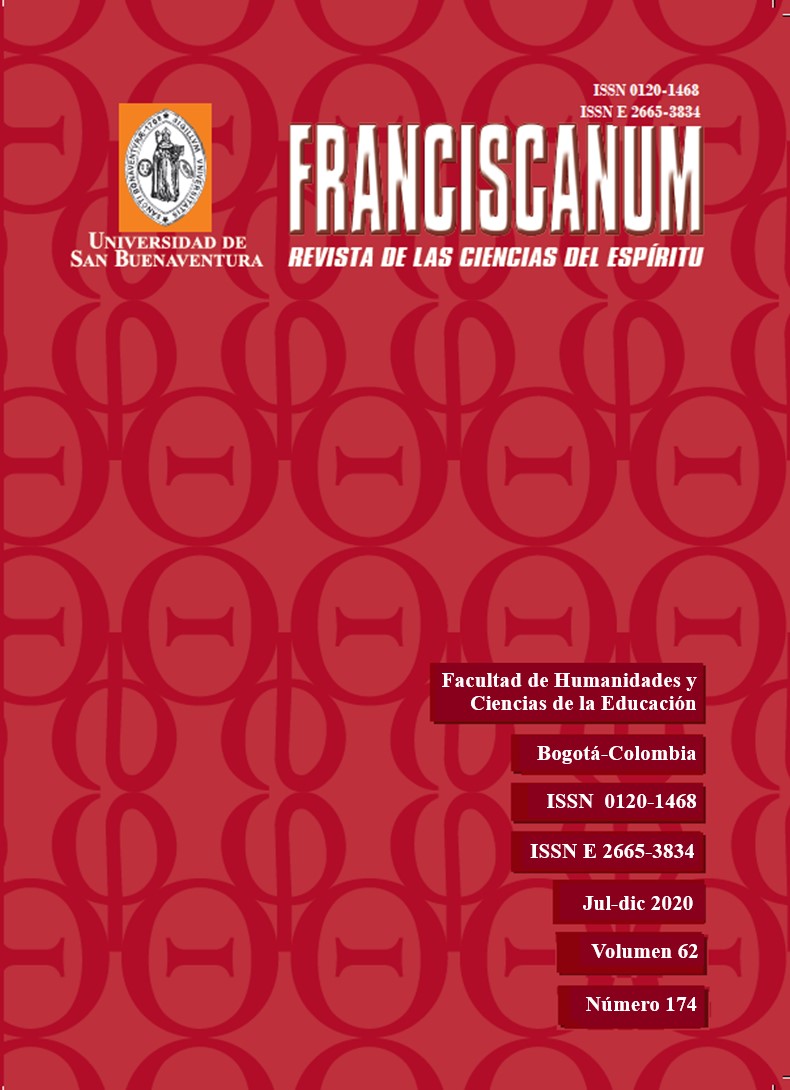This journal provides immediate open access to its content, based on the principle that giving the public free access to research helps a greater global exchange of knowledge.
Therefore, the Creative Commons 4.0 Attribution Attribution - Equal Share (by-sa) License is accepted: The commercial use of the work and the possible derived works is permitted, the distribution of which must be done with a license equal to that regulates the original work.
http://creativecommons.org/licenses/by-sa/4.0/
Along these same lines and in line with the Open Access policy, it is clarified that the authors maintain their rights to articles, without restrictions and, in the same way, they maintain their publication rights, without restrictions. They are only asked to reference the number of the Franciscanum magazine where the article initially appeared.
Abstract
The philosophical scoping often observes that both ugliness and evil have no entity and therefore can only be thought as diminished beauty and goodness. However, this diminishing entitlement is not only a lack, but may also bring about the possibility of greater beauty and goodness. In this sense, thinking about the beauty of evil has not been for many ancient and medieval authors a logical impossibility, but on the contrary a new way of speaking about the Beauty of the Universe. For many ancient and medieval authors, thinking of the beauty of evil has not been a logical impossibility, but on the contrary, a new way of speaking of the Beauty of the Universe. This has been the Augustinian and Dionysian approach, and it is also the one assumed by the well-known Summa Halensis, although from a perspective whose originality lies in the integration of these traditions. The intention of the present work is to analyze how the Summa Halensis understands that beauty is capable of integrating evil.
Keywords:
References
Agustín De Hipona. «Del orden». En Obras de San Agustín, vol. I. Traducido por Victorino Capánaga. Madrid: BAC, 1969.
Agustín De Hipona. «De la verdadera religión». En Obras de San Agustín, vol. IV. Traducido por Victorino Capánaga. Madrid: BAC, 1956.
Agustín De Hipona. «Del Génesis a la letra». En Obras de San Agustín, vol. XV. Traducido por Balbino Martín. Madrid: BAC, 1957.
Agustín De Hipona. «Del libre arbitrio». En Obras de San Agustín, vol. III. Traducido por Evaristo Seijas. Madrid: BAC, 1963.
Agustín De Hipona. «La Ciudad de Dios». En Obras Completas de San Agustín, vol. XVI. Traducido por Santos Santamarta del Río y Miguel Fuertes Lanero. Madrid: BAC, 1988.
Agustín De Hipona. «Ochenta y tres cuestiones diversas» en Obras de San Agustín, vol. XL. Traducido por Teodoro C. Madrid. Madrid: BAC, 1995.
Alejandro De Hales. Summa Theologica I. Florencia: Quaracchi-Ex Typogrphia Collegii S. Bonaventura, 1924.
Alejandro De Hales. Summa Theologica II. Ed. Florencia: Quaracchi-Ex Typogrphia Collegii S. Bonaventura, 1928.
Alejandro De Hales. Summa Theologica III. Florencia: Quaracchi-Ex Typogrphia Collegii S. Bonaventura, 1930.
Aristóteles. Ética Nicomaquea. Traducido por María Araujo y Julián Marías. Madrid: Centro de Estudios Constitucionales, 1989.
Benavides, Verónica. «La influencia de San Agustín en la doctrina de la creación de Alejandro de Hales». Teología y Vida 1, Vol. 56 (2015): 9-36.
De Bruyne, Edgar. Estudios de Estética Medieval. Traducido por Armando Suárez, Madrid: Gredos, 1959.
De Estrasburgo, Ulrico. Summa de Bono. Corpus Philosophorum Teutonicorum Medii Aevii. Editado por Kurt Flasch y Loris Sturlese. Hamburgo: Felix Meiner Verlag, 1987.
Dionisio Areopagita. Los Nombres Divinos. Traducido por Josep Soler. Barcelona: Antoni Bosch, 1980.
Doucet, Victorine. «The history of the problem of the authenticity of the Summa». Franciscan Studies 3, Vol. 7 (1947): 274-312.
Eco, Umberto. Il problema estetico in San Tommaso. Torino: Edizioni di «Filosofia», 1956.
Eco, Umberto. Arte y belleza en la estética medieval. Traducido por Helena Lozano Miralles. Barcelona: Lumen, 1999.
El Canciller, Felipe. Summa de Bono. Editado por Nicolai Wicki. Berne: Francke, 1985.
Gilson, Etienne. Introduction a l’etude de Saint Augustin. Paris: Libraire Philosophique J. Vrin, 1982.
Harrison, Carol. Beauty and revelation in the thought of Saint Augustine. Oxford: Clarendon Press, 1992.
Merino, José Antonio y Martínez Fresneda, Francisco. Manual de Teología Franciscana. Madrid: BAC, 2003.
Rey Altuna, Luis. Qué es lo bello. Introducción a la estética de San Agustín. Madrid: Consejo superior de investigaciones científicas, 1945.
Tomás De Aquino. Summa Theologiae. Ed. Leonina, Madrid: BAC, 1978.



















